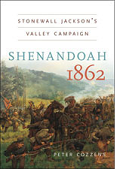 Today I finished reading 1862: Stonewall Jackson's Valley Campaign by Peter Cozzens. My daily 3+ hour train commute is enabling me to complete 500+ page books in a little over two weeks, so I guess it’s not all bad that I never see daylight on workdays. This book left me with a variety of reactions and I am adding a great deal of newfound knowledge to my prep for a banquet talk that I am doing this summer at the CWHC Muster in Lexington titled Lion in the Valley: Stonewall Jackson's 1862 Valley Campaign.
Today I finished reading 1862: Stonewall Jackson's Valley Campaign by Peter Cozzens. My daily 3+ hour train commute is enabling me to complete 500+ page books in a little over two weeks, so I guess it’s not all bad that I never see daylight on workdays. This book left me with a variety of reactions and I am adding a great deal of newfound knowledge to my prep for a banquet talk that I am doing this summer at the CWHC Muster in Lexington titled Lion in the Valley: Stonewall Jackson's 1862 Valley Campaign.
Cozzens contribution is refreshingly original and does an excellent job of presenting the perspectives of both sides. In doing so we are given a very balanced presentation of the events from both Federal and Confederate witnesses, in both positive and negative lights. This book pulls no punches when taking commanders to task and clearly shows that even Jackson’s genius was flawed at times during this campaign. He was not tactically perfect by any means regardless of his troop’s tremendous accomplishments and his subordinates were not always on board with the general’s orders. I will be sure to keep Stonewall’s “boots on the ground” in my presentation, (which may surprise some people) and I now have some great recollections from the Union-side to add.
As a straight military-history, 1862 is a great read. The author does a very good job of presenting the engagements coherently and his tasteful use of maps compliments the narrative. As this particular campaign resulted in multiple battles and skirmishes, there are plenty of firsthand combat accounts, and I have a newfound appreciation for the suffering of both the soldiers and the civilian population. Cozzen’s writing style is also vivid and I am thankful that I have toured several of the fields he paints including the often overlooked Kernstown. As a result, I could easily envision the topography and primary sites of interest. To be honest, I was not aware of the number of fights that occurred in the valley during this period.
The most striking revelation for me (as a student of Jackson) is how much the author’s depiction of Stonewall reminds me of Gen. George S. Patton. I recall reading a quote from a WW2 veteran of the legendary 3rd Army in which he offered what is was like to fight under the tenacious tank commander. He said, “They called him [Patton] ‘Old blood and guts.” Stating that the moniker was accurate only to a point he added, “It was true…our blood and his guts.” The marches (and counter-marches) that were conducted by the Valley Army are hard to believe at times in both the sheer distance covered, and the natural obstacles that they traversed. Frankly, the simple movement of men during the campaign is equally astounding and disturbing. I would have understood one’s desire to desert after a third trip back up the mountain.
The ONLY disappointment with this book (and more of a personal issue), is the miniscule coverage of the death of Turner Ashby. It’s no secret that this controversial cavalryman is a favorite character of mine and I unashamedly included him in my Top 10 Confederate Generals feature that I penned for Civil War Historian magazine. Much to my dismay (as I anticipated reaching this event from the very first page) 1862 gives a brief recap of Ashby’s death and his postmortem evacuation. I really wanted to know more about the scene and the affect of the Black Knight’s death on the morale of his men. I’ll be quoting some tearful recollections from Ashby’s troopers in my talk and I wish that Cozzen would have spent a little more time doing the same. That said, I highly recommend 1862: Stonewall Jackson's Valley Campaign and will be using it as a valuable source for my talk.
Tomorrow I start reading The Civil War: Tullahoma to Meridian by Shelby Foote to finish out the year.
Updated: Thursday, 10 December 2009 8:28 AM EST
Permalink | Share This Post





